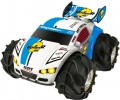Battery capacity
The capacity of the battery supplied with the electric motor model (see "Motor"). Indicated only for variants using original batteries (see "Battery type"), measured in ampere-hours: 1 Ah corresponds to the capacity at which the battery is capable of delivering a current of 1 A for 1 hour.
The higher the capacity of the battery, the longer, usually, the “device” is able to work without recharging. However, the practical time of operation on a charge is largely determined by other characteristics of the machine — scale, purpose (see both points above), weight, model and engine power, etc. Therefore, in most cases, this parameter plays a purely reference role, and it is only possible to compare the battery capacity among themselves with machines that do not have any significant differences in other characteristics.
Radio frequency
The frequency at which the transmitter of the model control box operates.
— 27.145 MHz. One of the frequencies used for radio remote control for a long time; in some CIS countries it is even reserved by state regulatory bodies for this very purpose. Such transmitters are relatively inexpensive, but suffer from one serious drawback: they do not provide channel separation when several consoles are operating in close proximity to each other. In other words, if the machine stays in the coverage area of two transmitters, the signals from them will be mixed, which is actually tantamount to a loss of control. This is most often unimportant for recreational models, however, in competitions with several cars on the track at the same time, it can create serious problems and requires tricks with the design of the frequency grid and the use of interchangeable crystal oscillators. As a result, in professional motorsport, this frequency is gradually being replaced by the more advanced 2.4 GHz standard.
Separately, we note that among car models there may be transmitters with frequencies of 35, 40 and 75 MHz; according to the main features, they are completely similar to the described 27.145 MHz and differ only in the operating frequency.
— 2.4 GHz. The most advanced communication standard to date, used by remote control cars. Its main feature (and difference from those described above) is the possibility of normal operation of several transmitters of this...format in close proximity to each other. To do this, various technologies are used that provide automatic distribution of receiver-transmitter pairs over their own channels (similar to how it happens, for example, in mobile communications). Theoretically, the 2.4 GHz band may be more prone to interference, as many modern electronics work in it (in particular, Wi-Fi and Bluetooth modules); however, due to the aforementioned distribution of channels, such problems arise only in very unfortunate cases.
Range
The greatest distance between the remote control and the machine, at which the transmitter of the remote control is still able to guarantee normal controllability of the model. Note that official specifications usually provide data for perfect conditions: full battery charge, no obstacles in the signal path, extraneous interference, etc .; in fact, the range may be somewhat less. However, according to this parameter, it is quite possible to compare different models of radio-controlled cars with each other.
The higher this indicator, the farther you can let go of the machine from the remote control, the less often you have to move to keep control. However, a large range means not only a long range as such — it also speaks of a good signal penetration, its ability to pass through various obstacles.
Power source
The type and number of batteries required for the operation of the model control panel.
— AA. Replaceable cells, known in everyday life as "finger-type batteries". They can be produced not only in the form of disposable batteries, but also in the form of rechargeable batteries. In both cases, they are available in a wide range of items that differ in price and quality, which gives freedom of choice; batteries are sold almost everywhere and are inexpensive. The power and capacity of AA elements are relatively small, but in most cases they are quite enough for normal operation of the transmitter for quite a long time. Usually, modern remotes require several of these batteries — usually 2, 4 or 6.
— AAA. Replaceable cells, known as "mini finger" or "little" batteries. From the AA batteries described above, they differ only in their smaller size and, accordingly, in their capacity; the rest are completely similar. They are mainly used in remotes for inexpensive entertainment models: such remotes do not require a lot of energy, but compactness is sometimes crucial.
— PP3. Replaceable batteries of a characteristic rectangular shape, with a pair of contacts on one of the ends. They have a nominal voltage of 9 V. Such elements are quite popular in "entertainment" models designed for children — not least because only one battery is enough for the remote control.
— Accumulator. In this case, a specialized battery is meant, either of an original d...esign, or in a size that is not related to replaceable elements. These power supplies can be far superior to battery packs in terms of power and capacity, but they are not cheap, and such advanced features are rarely needed in fact. Therefore, battery remotes are found mainly among large-scale professional-level models, with increased requirements for the range and reliability of the transmitter on the remote control.

